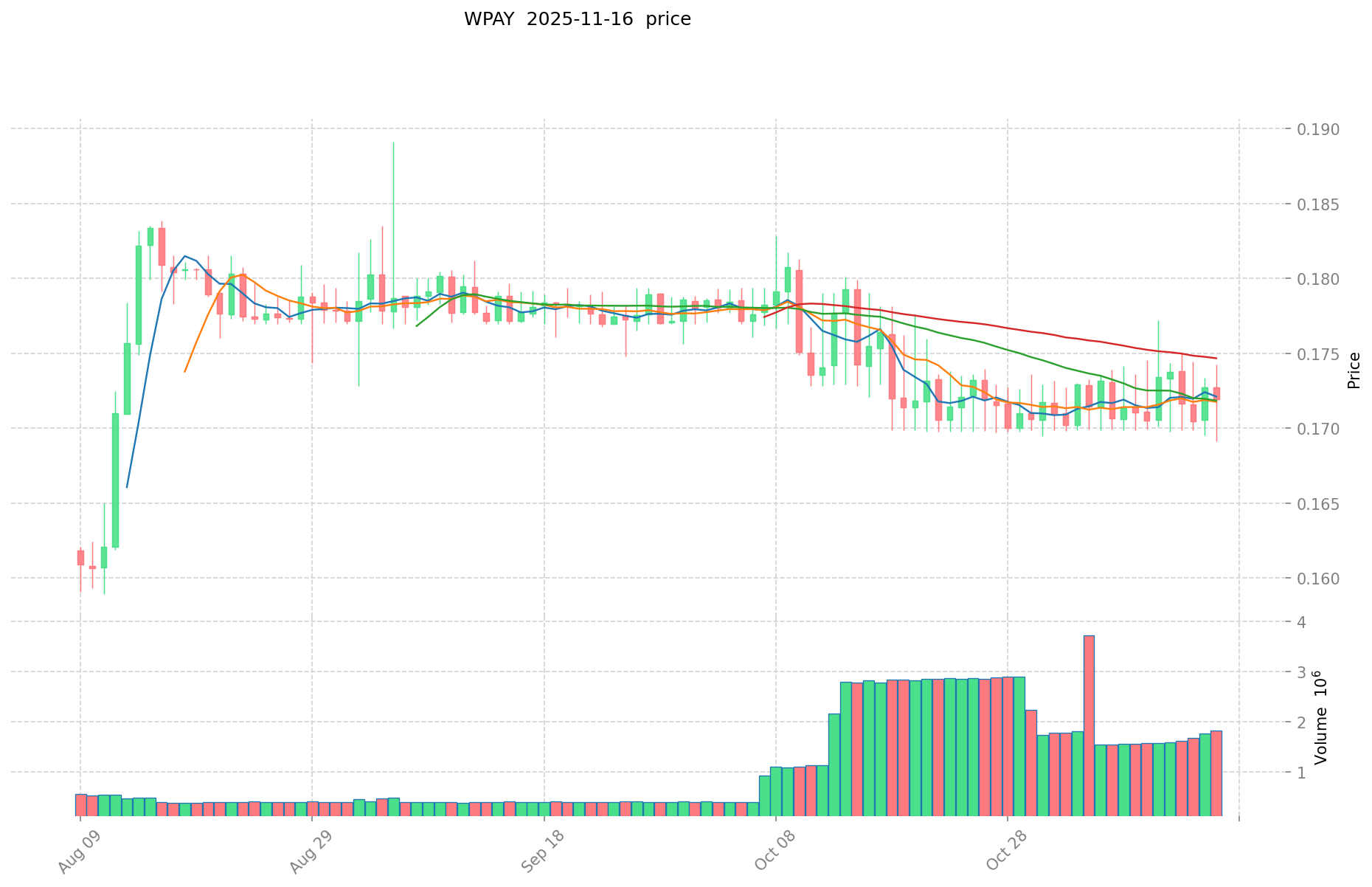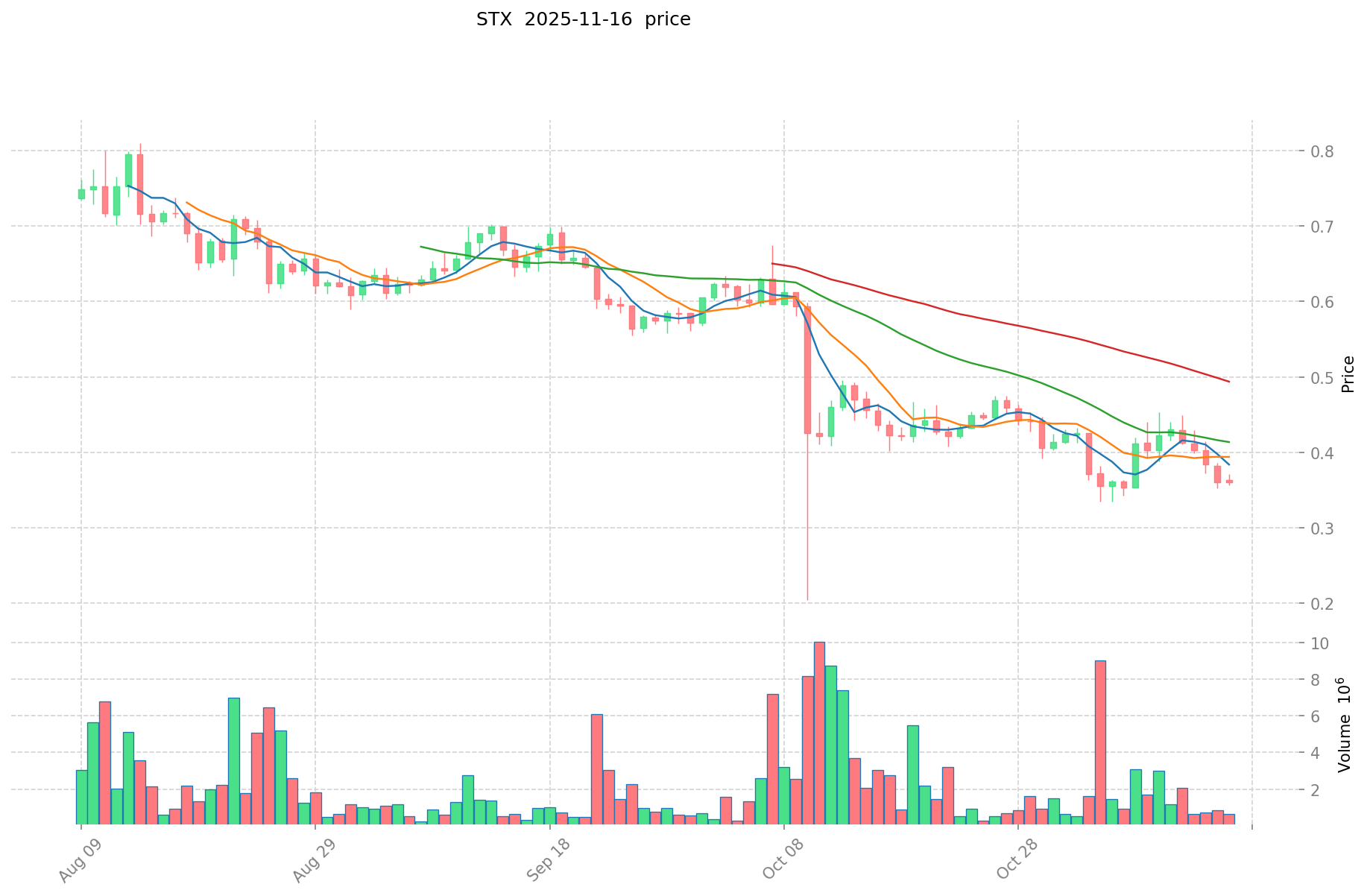WPAY vs STX: Comparing Digital Payment Solutions for the Modern Consumer
Introduction: Investment Comparison of WPAY vs STX
In the cryptocurrency market, the comparison between Wirex Pay vs Stacks has been an unavoidable topic for investors. The two not only differ significantly in market cap ranking, application scenarios, and price performance but also represent different positioning in crypto assets.
Wirex Pay (WPAY): Since its launch in 2024, it has gained market recognition for its innovative approach to digital payments and integration of blockchain technology with traditional finance.
Stacks (STX): Introduced in 2019, it has been hailed as a new internet for decentralized applications, aiming to empower users with better control over their data.
This article will provide a comprehensive analysis of the investment value comparison between WPAY and STX, focusing on historical price trends, supply mechanisms, institutional adoption, technological ecosystems, and future predictions, attempting to answer the question investors are most concerned about:
"Which is the better buy right now?"
I. Price History Comparison and Current Market Status
WPAY and STX Historical Price Trends
- 2024: WPAY launched with an initial price of $0.05, reaching its all-time high of $0.26849 on November 26, 2024.
- 2020: STX hit its all-time low of $0.04559639 on March 13, 2020, during the global market crash.
- Comparative analysis: While WPAY is a relatively new token with limited historical data, STX has shown significant volatility, reaching an all-time high of $3.86 on April 1, 2024, before declining to its current price.
Current Market Situation (2025-11-16)
- WPAY current price: $0.17262
- STX current price: $0.3607
- 24-hour trading volume: WPAY $319,764.88 vs STX $171,855.19
- Market Sentiment Index (Fear & Greed Index): 10 (Extreme Fear)
Click to view real-time prices:
- Check WPAY current price Market Price
- Check STX current price Market Price


II. Core Factors Affecting Investment Value of WPAY vs STX
Supply Mechanisms Comparison (Tokenomics)
-
WPAY: Fixed maximum supply of 1 billion tokens with 25% allocated to the team (locked for 4 years), 35% for the ecosystem, 15% for strategic reserves, and 25% for public sales
-
STX: Decreasing block rewards with halvings every 4 years, maximum supply of approximately 1.818 billion STX, with 38% allocated to early contributors, 33% for the ecosystem, 9% for the foundation, and 20% for miners
-
📌 Historical pattern: Limited supply assets like WPAY and STX with halvings tend to experience price appreciation during supply shocks and decreasing inflation rates.
Institutional Adoption and Market Applications
- Institutional holdings: STX has attracted more institutional interest due to its established Bitcoin connection and longer market presence
- Enterprise adoption: STX offers Bitcoin-based smart contracts for financial applications, while WPAY focuses on payment processing and commerce applications
- National policies: Regulatory frameworks for both tokens remain evolving, with STX benefiting from clearer regulatory status in some jurisdictions due to its longer history
Technical Development and Ecosystem Building
- WPAY technical upgrades: Integration with Web3Pay and cross-chain capabilities enabling transactions across multiple blockchain networks
- STX technical development: Implementation of Stacks 2.0 with Proof of Transfer consensus mechanism and Clarity smart contract language specifically designed for Bitcoin integration
- Ecosystem comparison: STX has a more developed ecosystem with applications in DeFi, NFTs, and smart contracts, while WPAY's ecosystem focuses primarily on payment processing and merchant integrations
Macroeconomic Factors and Market Cycles
- Performance during inflation: Both assets position themselves as inflation hedges, with STX having a longer track record during inflationary periods
- Macroeconomic monetary policy: Interest rate fluctuations affect both tokens similarly to other crypto assets, with risk-on sentiment generally benefiting during low interest rate environments
- Geopolitical factors: Cross-border transaction demand potentially benefits both tokens, with WPAY's payment focus potentially offering advantages during periods of increased global commerce
III. 2025-2030 Price Prediction: WPAY vs STX
Short-term Prediction (2025)
- WPAY: Conservative $0.0979 - $0.1718 | Optimistic $0.1718 - $0.2337
- STX: Conservative $0.3303 - $0.3590 | Optimistic $0.3590 - $0.5134
Mid-term Prediction (2027)
- WPAY may enter a growth phase, with an estimated price range of $0.1549 - $0.2740
- STX may enter a bullish market, with an estimated price range of $0.4323 - $0.7412
- Key drivers: Institutional capital inflow, ETF, ecosystem development
Long-term Prediction (2030)
- WPAY: Base scenario $0.2276 - $0.3671 | Optimistic scenario $0.3671 - $0.4368
- STX: Base scenario $0.5179 - $0.8632 | Optimistic scenario $0.8632 - $0.9581
Disclaimer
WPAY:
| 年份 | 预测最高价 | 预测平均价格 | 预测最低价 | 涨跌幅 |
|---|---|---|---|---|
| 2025 | 0.2337024 | 0.17184 | 0.0979488 | 0 |
| 2026 | 0.27374112 | 0.2027712 | 0.166272384 | 17 |
| 2027 | 0.273994584 | 0.23825616 | 0.154866504 | 38 |
| 2028 | 0.3713817894 | 0.256125372 | 0.1792877604 | 48 |
| 2029 | 0.420429798138 | 0.3137535807 | 0.181977076806 | 81 |
| 2030 | 0.43683911040861 | 0.367091689419 | 0.22759684743978 | 112 |
STX:
| 年份 | 预测最高价 | 预测平均价格 | 预测最低价 | 涨跌幅 |
|---|---|---|---|---|
| 2025 | 0.51337 | 0.359 | 0.33028 | 0 |
| 2026 | 0.5932116 | 0.436185 | 0.22245435 | 21 |
| 2027 | 0.741165552 | 0.5146983 | 0.432346572 | 42 |
| 2028 | 0.86026673862 | 0.627931926 | 0.33908324004 | 74 |
| 2029 | 0.9822111186492 | 0.74409933231 | 0.6473664191097 | 106 |
| 2030 | 0.958102300282356 | 0.8631552254796 | 0.51789313528776 | 139 |
IV. Investment Strategy Comparison: WPAY vs STX
Long-term vs Short-term Investment Strategy
- WPAY: Suitable for investors focused on payment solutions and ecosystem potential
- STX: Suitable for investors seeking Bitcoin-based smart contracts and established ecosystem
Risk Management and Asset Allocation
- Conservative investors: WPAY 30% vs STX 70%
- Aggressive investors: WPAY 60% vs STX 40%
- Hedging tools: Stablecoin allocation, options, cross-currency portfolios
V. Potential Risk Comparison
Market Risk
- WPAY: Limited historical data, potential volatility due to newer market presence
- STX: Exposure to Bitcoin market fluctuations, higher volatility historically
Technical Risk
- WPAY: Scalability, network stability
- STX: Mining concentration, security vulnerabilities
Regulatory Risk
- Global regulatory policies may impact both differently, with STX potentially having a clearer regulatory status in some jurisdictions due to longer market presence
VI. Conclusion: Which Is the Better Buy?
📌 Investment Value Summary:
- WPAY advantages: Focus on payment solutions, integration with Web3Pay, cross-chain capabilities
- STX advantages: Established Bitcoin connection, more developed ecosystem, longer market presence
✅ Investment Advice:
- New investors: Consider a balanced approach, leaning towards STX for its established ecosystem
- Experienced investors: Explore WPAY for potential growth, while maintaining STX exposure
- Institutional investors: Focus on STX for its institutional adoption and Bitcoin-based smart contracts
⚠️ Risk Warning: The cryptocurrency market is highly volatile. This article does not constitute investment advice. None
VII. FAQ
Q1: What are the main differences between WPAY and STX? A: WPAY focuses on digital payments and blockchain integration with traditional finance, launched in 2024. STX, introduced in 2019, aims to create a new internet for decentralized applications with Bitcoin-based smart contracts.
Q2: How do the supply mechanisms of WPAY and STX compare? A: WPAY has a fixed maximum supply of 1 billion tokens, while STX has a maximum supply of about 1.818 billion with decreasing block rewards and halvings every 4 years.
Q3: Which token has shown better price performance historically? A: STX has a longer price history and has shown significant volatility, reaching an all-time high of $3.86 in April 2024. WPAY, being newer, has limited historical data but reached its all-time high of $0.26849 in November 2024.
Q4: How do the ecosystems of WPAY and STX differ? A: STX has a more developed ecosystem with applications in DeFi, NFTs, and smart contracts. WPAY's ecosystem primarily focuses on payment processing and merchant integrations.
Q5: What are the key factors affecting the investment value of these tokens? A: Key factors include supply mechanisms, institutional adoption, technical development, ecosystem building, and macroeconomic factors such as inflation and interest rates.
Q6: What are the long-term price predictions for WPAY and STX? A: By 2030, WPAY is predicted to reach $0.2276 - $0.4368, while STX is expected to reach $0.5179 - $0.9581 in base and optimistic scenarios respectively.
Q7: How should investors approach risk management when investing in WPAY and STX? A: Conservative investors might consider allocating 30% to WPAY and 70% to STX, while aggressive investors might opt for 60% WPAY and 40% STX. Hedging tools like stablecoins, options, and cross-currency portfolios can also be used.
Share
Content